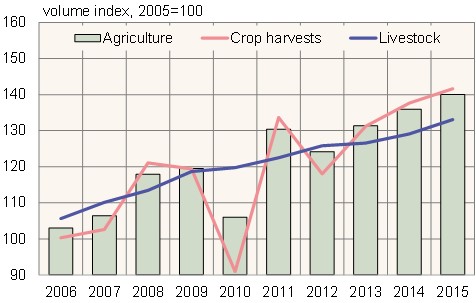BOFIT Weekly Review 33/2016
Russian farm production growing gradually
Bans on imports of certain foods and policies favouring domestic producers have had only minor impact on production volumes of domestic farmers. Russian production of grains and livestock has grown a few per cent a year in recent years. The value of total agricultural output as well as livestock production in 2015 grew 3 % in real terms and has continued to increase at the same pace in 2016. Grain harvest was last year approximately on the previous year’s level. However, production of certain other crops such as sugar beets and soybeans grew rapidly last year. This year’s grain harvest is expected to be considerably larger than last year’s.
Production of meat and poultry was up 4 % last year and about 6 % y-o-y in the first months of 2016. While dairy production has shown virtually no growth overall, production of certain dairy products has increased. Highest growth has been in cheese production, which was up 17 % last year. Growth in cheese production appears to have levelled off, however, at around 2 % growth in the first half of this year. This year, especially production of certain vegetables has grown rapidly. Food production overall rose 2 % in 2015 and 3 % y-o-y in 1H16.
Retail food sales continue to diminish, but reduced foreign competition has allowed domestic producers to increase their market shares. The absence of competition has allowed price increases, which has enhanced profits of both farmers and the food industry. Even so, there are no signs of increased investment in the sector. In 2015, investment in farming and livestock fell 13 %.
With the contraction in real incomes and rapidly rising prices for many food items, food represents an increasingly large share of household consumption. At the end of 2015, food accounted for about 30 % of the consumer spending of Russian households.
Russian agricultural output 2006–2015
Sources: Rosstat, BOFIT